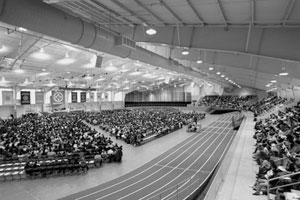 |
|
||
|
|||
State-of-the-art track and tennis center opens
By Brian Fitzgerald
It would be difficult to find anyone more pleased with the recent completion
of BU's new track and tennis center than women's tennis coach Lesley Sheehan
(SED'84) - and not just because the number of courts on campus has more
than doubled, from three to seven.
|
|
|
| Construction of the new track and tennis center was completed just in time for Matriculation. BU previously held the annual ceremony at the Commonwealth Armory, which was demolished over the summer to make way for a portion of the John Hancock Student Village. Photo by Kalman Zabarsky | |
"Our program has existed since 1975 without any indoor facilities
on campus," she says. "Having a place to practice and play during
bad weather will definitely help our recruiting efforts. And we'll be
able to have more home matches. I'm excited."
The 60,000-square-foot building on Ashford Street is part of the $200
million multistage West Campus Student Village project, designed to be
the thriving center of student life at BU. The project's first phase,
the 817-bed Student Village Apartments, was completed two years ago at
10 Buick St. Next to be constructed - by late 2004 - will be a sports
and entertainment arena along with a fitness and recreation center on
the site of the Commonwealth Armory, which was demolished in August. Additional
residence halls will also be built on the site.
The air-conditioned track and tennis center includes four regulation tennis
courts, a fixed-bank 200-meter track, and a separate area for throwing
events, and has a seating capacity of 1,500 spectators. In addition, it
has individual offices for track, tennis, cross-country, and intramural
sports, and serves as a practice venue for other Terrier athletic teams
and organizations.
It is also used for such large-scale events as the annual Freshman Matriculation.
Sheehan, who has coached the tennis team for 17 years - and is generally
considered the best women's player in BU history - hasn't had many problems
recruiting students to play for the premier program in the America East
conference. The Terriers have won the league for an unprecedented 8 straight
years and 12 of the last 13. However, the University's three outdoor courts,
shared with the entire BU community, wasn't exactly the tennis program's
biggest drawing card. "The recruits know that Boston is a large city,
and there are plenty of courts in the area," she says. "Also,
they know that BU has so much to offer academically. But as far as indoor
courts are concerned, we've been bouncing around the past couple of years,
going to courts at Harvard and MIT." The team lost its indoor home
in 1999, when the indoor tennis club at Charles River Park in Boston's
West End was bought by Basketball City, which now operates corporate basketball
leagues there. BU had practiced and played at this "bubble"
building for 20 years.
In terms of recruiting, men's track coach Pete Schuder says he has already
felt the benefits of the new building, with a much larger group of athletes
interested in BU this year. The Armory, built 1916 and acquired by the
University in 1983, has been the indoor home for Terrier runners since
1979. The unusually springy bounce of its running track was a contributing
factor in some of the fastest times turned in during the collegiate indoor
season. According to Schuder, the new track will be even faster. "The
new facility will mean a great deal to our track and field program,"
he says. "We've been long considered a strong Division I program
with a very fast indoor track, but we no longer have to feel embarrassed
by the dirt and grime of the old Armory."
Bruce Lehane, distance coach for the men's and women's track teams, as
well as head cross country coach, certainly won't shed any tears over
the loss of the Armory. "It was a great asset, no doubt, and kept
our program functioning well," he says. "It provided the scene
for hundreds of great events over the years, and played a major role in
track at Boston University and in New England. But it has now been surpassed.
The new facility was constructed with track in mind, whereas the Armory
was built for the National Guard."
Michael Lynch, assistant vice president for recreation and athletics development
at BU, says the facility "is going to be arguably the best in the
Northeast for track and tennis." He expects that the building will
have an impact on athletics donations from alumni, parents, and friends
of BU. "It will really help us in terms of fundraising," he
says. "The track and tennis center is the most modest of the three
athletics facilities we're going to build, so when the BU community and
the general public walk in there and see the big changes, they're going
to have some indication of what is to come in the next two years - when
the arena and the fitness and recreation center are built."
Lehane is enthusiastic about the amenities at the track and tennis center.
"It has a safe throwing area, proper public facilities, a first-rate
ventilation system, a first-rate audio system, a large electronic scoreboard,
locker rooms, office space, and security components," he says. "The
old Armory had none of these things. New isn't always better than old,
but in this case it is."
![]()
6 September 2002
Boston University
Office of University Relations
